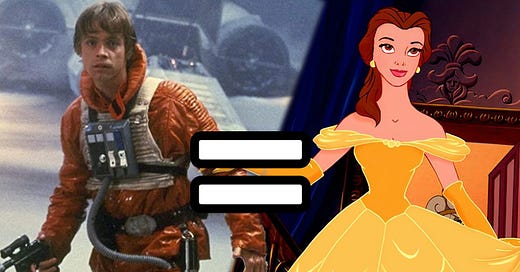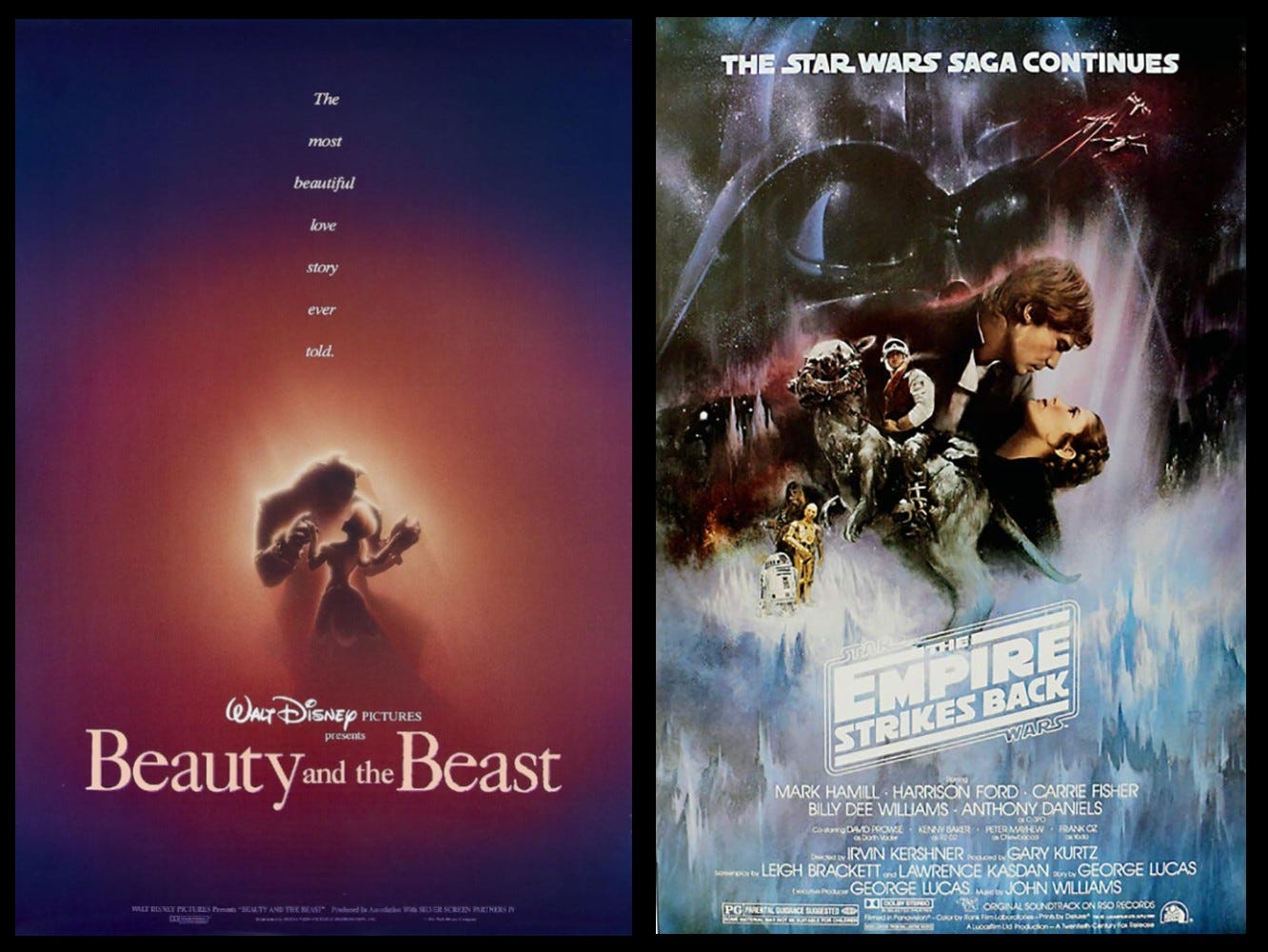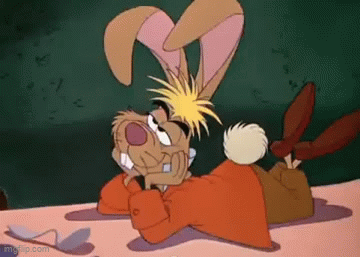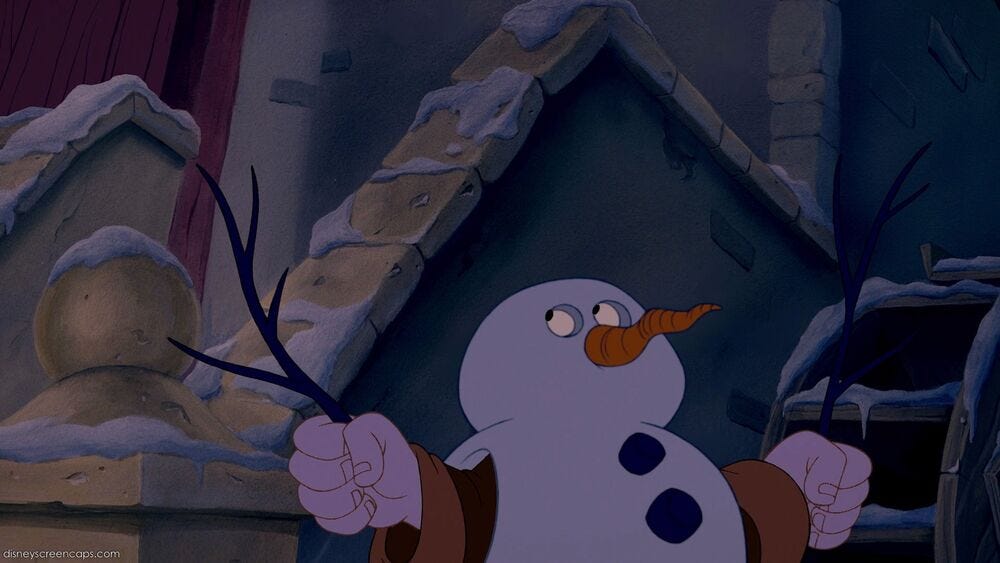Caveat: what you’re about to read is a nitpick. Both of these films are rightly considered classics, and none of what I’m about to say is meant to “ruin” the movies.
I was watching Beauty and the Beast1 with my daughter yesterday, and I was suddenly struck by a strange similarity with another movie—The Empire Strikes Back.
Both films have an A and B plot running (seemingly) simultaneously. But the in-universe time that passes does not seem the same in both storylines.
First consider Beauty and the Beast—
Belle spends what appears to be at least half a year in the Beast’s castle, as the seasons change.
Her father finds his way home, asks the villagers for help, then attempts to return to the castle, over a span maybe a couple of days.
Episode IV is similar—
Luke crashes on Dagobah, meets Yoda, and trains with him for what seems2 to be several months.
Han and Leia flee Darth Vader for a few days.
Indefinite Time
Now, of course, no one actually says how long any of these things take to happen. These are just my impressions. Yours may be different, but when I’ve mentioned this to others, a lot of people seem to agree there’s a discrepancy in the timelines. But it’s all fridge logic, isn’t it?
You don’t notice anything wrong while you’re watching the movies. I suspect it has to do with what Russian literary theorists call fabula and syuzhet. The former means the order of events as they occur in universe; the latter refers to the order in which the events are presented to the audience. These concepts usually come up in discussions of movies with achronological timelines, like Reservoir Dogs or Memento.
But the truth is, every writer has to decide on the syuzhet, even if that decision is to stick to simple chronological order.
Another example of syuzhet that’s so common we rarely think about is crosscutting—jumping back and forth between locations and storylines. Although it can be used in a variety of ways, one of the most common uses is showing simultaneity. When we cut from one location (and storyline) to the other and back again, we tend to get the impression that the events are happening at the same time.
By cutting back and forth between the A and B plots,3 both Beauty and the Beast and Empire Strikes Back make it seem like the two lines of action are happening concurrently,4 when they almost certainly are not.
Excuses, Excuses
As David Bordwell points out, crosscutting doesn’t necessarily imply that two lines of action are perfectly in sync:
Nearly all crosscutting in fictional cinema presumes different time spans, or rather different rates of change, in the crosscut lines of story action. We presume that overall the actions are simultaneous, but at a finer level, they proceed at different speeds. Some parts of the action in one line are skipped over, while other actions in another line are prolonged.
But that’s usually a disparity of minutes, maybe hours, not weeks or months.
Now, one could maybe justify the timeline shenanigans in Beauty and Empire with in-universe explanations. Han and Leia are traveling faster than light, so maybe there’s some time dilation going on. The Beast’s castle is magic—who knows how time works there?
That’s fine for head-canon, but there’s nothing in either movie that even hints at those theories. They’re simply post-facto justifications.
Update 2/20/25
I'm enough of a nerd to know that "Traveling through hyperspace" is not the same thing as flying faster than light. It's a kind of alternate dimension in the Star Wars universe. Thus, most ships had two engines, a main drive and a hyperdrive. I always took Han's boast that "She'll make .5 past light speed" as an indication that the Millennium Falcon can go faster than light on it's regular engine, although still slower than traveling through hyperspace.
But according to Wookieepedia, that's not correct; it's apparently meant to be some measure of speed through hyperspace. Additionally, there are some theories that relativity (and thus time dilation) don't exist in Star Wars, because Lucas didn't actually understand how those worked. After all, Han's claim that "It's the ship that made the Kessel Run in less than twelve parsecs" is simply an error, because Lucas thought that was a measure of time.5
Whatever the case, the larger point I'm making remains true—the length of time Han, Leia et al. spend on the Falcon does not seem to match (according to film grammar) the amount of time Luke trains with Yoda.
The real question is, does it matter?
Logic and consistency have their place, but if you don’t notice something’s wrong while you’re watching the movie, it probably doesn’t matter that LeFou was standing outside Belle’s house until he became a literal snowman.
Cinema is beyond logic, in a lot of ways. They exist in the moment, as light projected on (or from) a screen. The director, writer, and editor all collaborate to create a narrative that flows over the audience in a visceral experience.
Nolan, Naturally
Which brings me to one of modern cinema’s most cerebral filmmakers—Christopher Nolan. Nolan plays with syuzhet throughout his career, with the exceptions of Insomnia (his first studio picture) and his Batsmen films.6 With regard to crosscutting timelines, he did what Beauty and Empire did, but intentionally and openly, in his World War II film Dunkirk.
Three different storylines take place in three separate locations, over three distinct timeframes.
On land (referred to as the Mole), soldiers await rescue for a week.
At sea, civilian sailors join the effort on the appointed day.
In the air, fighter pilot defend the mission in progress, for an hour.
As shown in this chart, Nolan freely crosscuts between these storylines.
The effect is thrilling. It gives the story a sense of momentum that it wouldn’t have if it was told linearly.7
When is a Flaw Not a Flaw?
All of which is to say, yeah, I noticed these things—as an adult—after having seen the films at least a dozen times. Are they even flaws? Certainly. Do they detract from the enjoyment of the movies? Not at all.
Not for me, anyway. It might be different for you, and that’s okay. I’m not suggesting you “turn your brain off;” I just think everyone has their own specific level for the suspension of disbelief.8 Your taste is your taste is your taste, and no one can take that away from you.
For a mass medium like Hollywood movies, the filmmakers usually try to go up to the line that covers the largest swath of the audience. If something bothers viewers in that moment, takes them out of the story because it’s illogical or confusing or whatever, that is a problem for the filmmakers to solve. If, as Hitchcock puts it, it only "hits you after you've gone home and start pulling cold chicken out of the icebox," then it’s not a problem at all.
Enjoy the movie!
The original Disney animated movie, not the live-action remake.
Who knows how long it takes to train a Jedi, but it’s got to be more than a couple of days, right?
Granted, Empire is much more even-handed than Beauty in the time devoted to each storyline.
For another great example of trickery through crosscutting, watch Silence of the Lambs.
There's a persistent rumor that this was originally intended to be Han's error, because in an earlier draft, he wasn't the captain. He was a crew member planning on stealing the ship and didn't actually know what he was talking about. But most contemporaneous evidence points to Lucas simply being confused.
Curiously, Man of Steel showed more experimentation with time than any of Nolan’s own superhero films. He’s credited with “story” on that script, so I have to wonder—without having access to all the drafts—if that’s his influence.
For a more detailed analysis, read Bordwell’s DUNKIRK Part 1: Straight to the good stuff.
And, of course, different genres demand different levels, as well.










It's important to note this isn't explained AT ALL in the movie, but the prevailing theory for Empire Strikes Back is that time is distorted on Dagobah because of all the Force energy on the planet.
As far as Beauty and the Beast is concerned, I was always more bothered by the fact that the Beast would've been roughly 11 years old when he was cursed 😳
syuzhet - I love finally having a word to describe something I've noticed but never had a word for. Thanks!
Excellent post, and a good reminder that stories aren't real - Meaning, we aren't trying to re-create reality with our characters, setting, or timeline, but are rather creating a story. This means the setting can and should be a facade, the characters one-dimensional (If need be), and the timeline totally bogus.